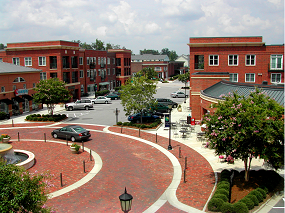Community Strategies

Creating or modifying environments to make it easier for people to walk or bike is a strategy that not only helps increase physical activity, but can make our communities better places to live. Communities designed to support physical activity are often called active communities. The Guide to Community Preventive Services recommends strategies to increase physical activity that are related to walkability—community-scale urban design, street-scale urban design, and improving access to places for physical activity (including providing maps and descriptive information).
Check out the resources below for even more ways to increase physical activity in the community.
Connecting Routes + Destinations

This package of resources can help state and local health departments, public health professionals, and community organizations as they aim to build more activity-friendly communities. To increase physical activity, the Community Preventive Services Task Force (CPSTF) recommends built environment approaches that combine one or more interventions to improve pedestrian or bicycle transportation systems (activity-friendly routes) with one or more land use and community design interventions (everyday destinations).
Additional Resources
Physical Activity in the Community
-
Active People, Healthy NationSM
CDC is working with states and communities to improve the built environment as part of Active People, Healthy Nation – Creating an Active America, TogetherSM. This initiative aims to help 27 million Americans become more physically active by 2027 to improve their overall health and quality of life and to reduce healthcare costs. -
CDC’s Designing and Building Healthy Places
This website offers tools and evidence-based health strategies for community planning, transportation, and land-use decisions. -
The CDC Guide to Strategies to Increase Physical Activity in the Community[PDF-1.2MB]
This document provides guidance for program managers, policy makers, and others on how to select strategies to increase physical activity in the community. -
Physical Activity Guidelines for Americans, 2nd edition
The U.S. Department of Health and Human Services has issued a new edition of the Guidelines to describe the amounts and types of physical activity needed to maintain or improve overall health and reduce the risk of chronic disease.
External Resources
Zoning for Walkability
Zoning regulations can be used to foster walkable communities. The following resources relate to this strategy.
-
Components of Local Land Development and Related Zoning Policies Associated with Increased Walking: A Primer for Public Health Practitioner [PDF-4.94MB]
This document provides a primer for public health practitioners and others interested in engaging with local planning and zoning officials. Specific community examples and links to key resources are provided through the primer along with a glossary of key terms used by the planning and zoning sectors. -
Zoning Code Reforms are Associated with Walking Behaviors in a Nationwide Evaluation [PDF-293KB]
This factsheet summarizes key findings from a recently completed nationwide evaluation of the relationship between zoning code reforms and both leisure time and active travel-related walking and activity. -
Zoning Elements are Associated with Walking Behaviors in a Nationwide Evaluation [PDF-489KB]
This factsheet summarizes key findings from a recently completed nationwide evaluation of the relationship between zoning elements supportive of walking and both leisure time and active travel-related walking.
This icon, ![]() , means that you are leaving cdc.gov and entering a non-federal website. View full disclaimer.
, means that you are leaving cdc.gov and entering a non-federal website. View full disclaimer.
- Page last reviewed: December 21, 2018
- Page last updated: December 21, 2018
- Content source:




 ShareCompartir
ShareCompartir